Parasitism- Evolution, Types, Principle, and Examples of Parasitism
What is Parasitism?
Parasitism is a type of symbiotic relationship between two organisms in which one organism, the parasite, benefits at the expense of the other organism, the host. The parasite lives in or on the host organism and relies on the host for survival and reproduction. Parasitism is a common ecological phenomenon found in all ecosystems, from the deep sea to the highest mountain peaks.
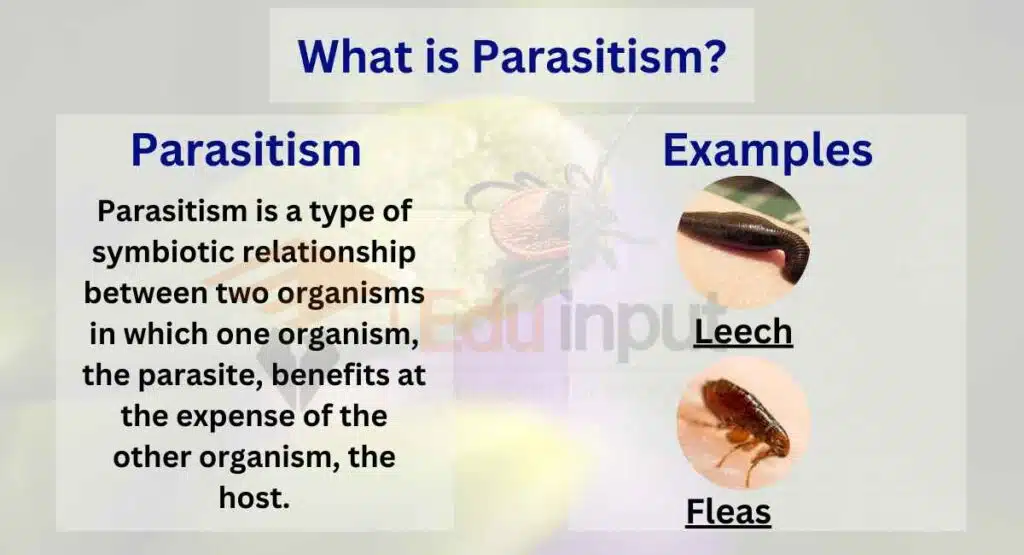
| Key Points |
|---|
| 1. Parasitism is a symbiotic relationship where one organism, the parasite, benefits at the expense of the other organism, the host. 2. Parasitism has evolved from mutualistic relationships, where both organisms benefit, through changes in behavior, morphology, and physiology over time. 3. The evolution of parasitism can be explained by theories such as the “life-history” hypothesis and the “arms race” hypothesis. 4. Examples of parasitism include tapeworms, fleas, ticks, lice, and parasitic fungi. 5. There are six types of parasitism: obligate parasitism, facultative parasitism, ectoparasitism, endoparasitism, social parasitism, and mesoparasitism. 6. The principle of parasitism is that the parasite benefits while the host is harmed, and parasites have evolved various mechanisms to exploit their hosts. 7. Parasitism occurs in animals, plants, and humans, and can also involve microbial parasites. It has ecological consequences, influences host populations and biodiversity, and is studied for biomedical research. Factors influencing parasitism include climate conditions, host behavior, population density, and more. |
Evolution Of Parasitism From Mutualism
Parasitism has evolved from mutualistic relationships, where both organisms benefit. The evolution of parasitism from mutualism involves changes in behavior, morphology, and physiology over time.
There are theories explaining the evolution of parasitism. The “life-history” hypothesis suggests that parasites evolve from mutualists when there is an increase in resource availability or reduced competition. This allows the parasitic organism to invest more energy in reproduction.
The “arms race” hypothesis proposes that parasitism evolves through a coevolutionary arms race between the parasite and the host. The parasite evolves to exploit the host’s resources more effectively, while the host develops defenses to counteract the parasite’s attacks.
Parasitism can also evolve from other symbiotic relationships. For instance, a mutualistic bacterium may become parasitic if it gains the ability to exploit the host’s resources. Similarly, a commensal organism living on a host may evolve into a parasite if it starts feeding on the host’s tissues.
Parasitism Examples
There are numerous examples of parasitism in nature. Some common examples include tapeworms in the intestines of animals, fleas on the skin of mammals, and mistletoe on the branches of trees. Other examples include ticks, lice, leeches, and parasitic fungi.
Types of Parasitism
There are 6 types of parasitism. Here are different types of parasitism along with examples for each category:
Obligate Parasitism
In this type of parasitism, the parasite is entirely dependent on the host to complete its life cycle. Examples include:
- Head lice (Pediculus humanus capitis)
- Plasmodium spp. (causative agents of malaria)
- Tapeworms (Cestoda)

Facultative Parasitism
Facultative parasites can survive and complete their life cycle either as parasites or in a free-living state. Examples include:
- Toxoplasma gondii
- Sacculina spp.
- Dodder (Cuscuta spp.)
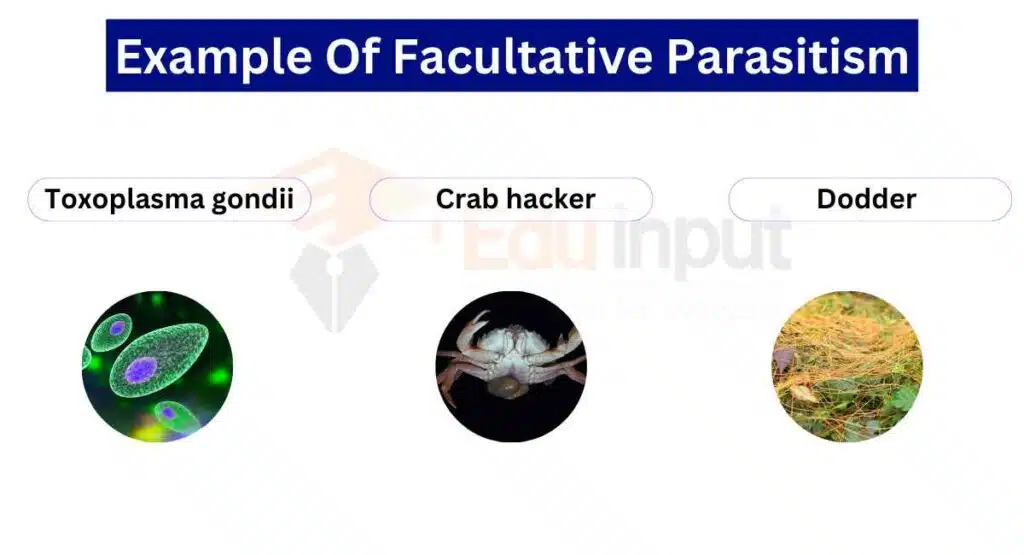
Ectoparasitism
In ectoparasitism, Ectoparasites reside on the external surface of the host and feed on its resources. Examples of ectoparasitism include:
- Fleas (Siphonaptera)
- Ticks (Ixodida)
- Leeches (Hirudinea)
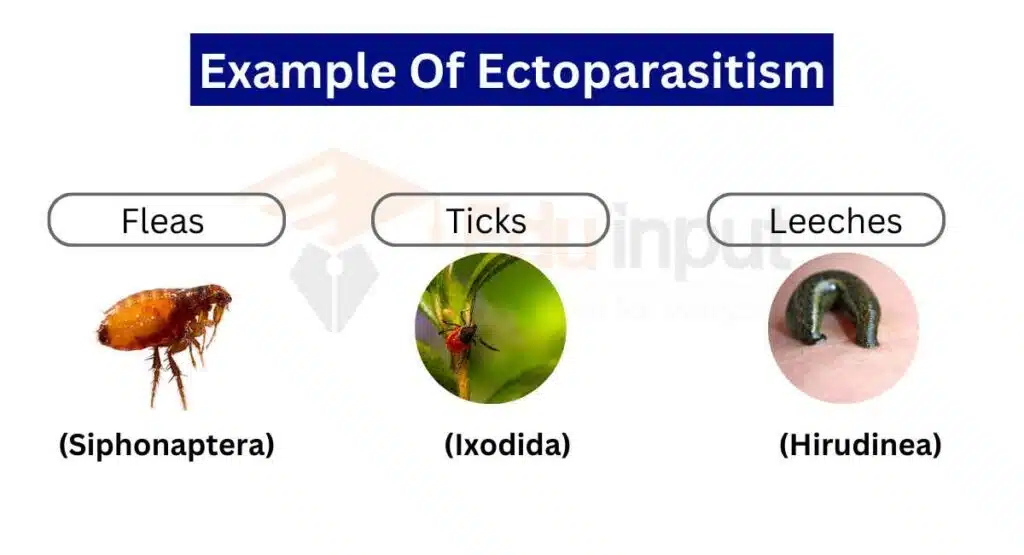
Endoparasitism
In endoparasitism, Endoparasites live inside the host’s body and obtain nutrients from internal tissues or organs. Examples of endoparasitism include:
- Hookworms (Ancylostoma spp.)
- Nematodes (roundworms)
- Malaria parasites (Plasmodium spp.)
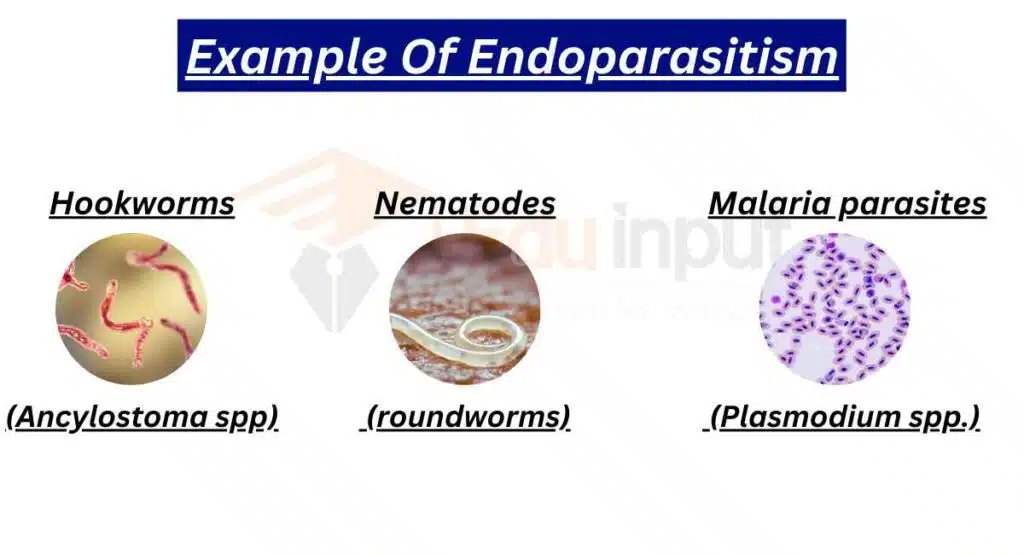
Social Parasitism:
In social parasitism, one species exploits the social behavior of another species for its benefit. Examples include:
- Cuckoo birds (Cuculidae) laying eggs in the nests of other bird species
- Cowbirds (Molothrus spp.) depositing eggs in the nests of other bird species
- Slave-making ants (Polyergus spp.) raiding the colonies of other ant species to enslave their workers
Mesoparasitism:
Mesoparasitism involves parasites that enters the external openings of the host’s body. Examples include:
- Nasal mites (Rhinonyssidae)
- Ear mites (Otodectes cynotis)
- Bladder worms (Capillaria spp.)
- Urogenital parasites such as the human pubic louse (Pthirus pubis)
Principle of Parasitism
The principle of parasitism is that the parasite benefits from the relationship, while the host is harmed. Parasites have evolved a variety of mechanisms to exploit their hosts, including the ability to manipulate the host’s behavior, suppress its immune system, and consume its tissues.
Parasitism in Animals
Parasitism is common in animals, and many animals have evolved adaptations to deal with parasitic infections. For example, some animals groom themselves to remove ectoparasites, while others have evolved immune systems that are effective at recognizing and destroying parasites. Parasites can have a significant impact on animal populations, causing reduced growth, decreased reproductive success, and increased mortality.
Parasitism in Plants
Parasitism is also common in plants, where parasitic plants attach themselves to the roots or stems of other plants to obtain nutrients. Examples of parasitic plants include mistletoe, dodder, and the broomrape family. Parasitic plants can cause significant damage to their hosts, reducing their growth and reproductive success.
Parasitism in Humans
Parasitism is also a significant health problem in humans, with many different types of parasites causing disease. Parasitic infections can be acquired through contaminated food or water, insect bites, or contact with infected animals. Examples of parasitic infections in humans include malaria, hookworm, and giardiasis.
Microbial Parasitism
Microbes can also be parasites, infecting other microorganisms or host organisms. Bacteria, viruses, and fungi can all act as parasites. For example, bacteria such as Mycobacterium tuberculosis can cause tuberculosis in humans, while viruses such as HIV can cause AIDS.
Ecological Consequences of Parasitism
Parasitism can have significant ecological consequences, affecting the interactions between different species in an ecosystem. Parasites can alter the behavior, physiology, and population dynamics of their hosts, and can have cascading effects on other species in the ecosystem. Parasites can also influence the evolution of their hosts, driving the evolution of resistance mechanisms and shaping the genetic diversity of populations.
Benefits Of Parasitism In Polluted Environment
Parasites are often thought of as harmful organisms that cause disease and damage to their hosts. However, recent research has shown that parasitism can have beneficial effects in polluted environments. Here are some of the benefits of parasitism in polluted environments:
- Bioremediation
- Indicator species
- Protection against toxins
- Increased biodiversity
- Resistance to pollution
Importance of Parasitism
Parasitism is an important ecological phenomenon with a significant impact on the biology of both hosts and parasites, as well as the functioning of ecosystems. Here are some of the key reasons why parasitism is important:
1. Regulation of host populations
Parasites can regulate host populations by reducing the survival, reproduction, or growth rates of their hosts. This can prevent the host population from becoming too large and potentially damaging the environment, as well as limit the spread of infectious diseases.
2. Maintenance of biodiversity
Parasites play an important role in maintaining biodiversity by influencing the structure and dynamics of ecological communities. Parasites can affect the behavior, morphology, and physiology of hosts, which can, in turn, affect their interactions with other species in the community.
3. Evolutionary drivers
Parasites can be important drivers of evolution, both in hosts and in parasites themselves. Hosts may evolve defenses against parasites, while parasites may evolve strategies to overcome host defenses.
4. Biomedical research
Parasites can serve as important models for biomedical research, particularly for studying the immune system and developing treatments for parasitic diseases.
5. Ecological indicators
Parasites can serve as important indicators of environmental health and ecosystem functioning. Changes in parasite communities can be used to monitor environmental changes, such as pollution, habitat loss, or climate change.
Factors Affecting Parasitism
Here is the list of factors influencing host-parasite associations in parasitism:
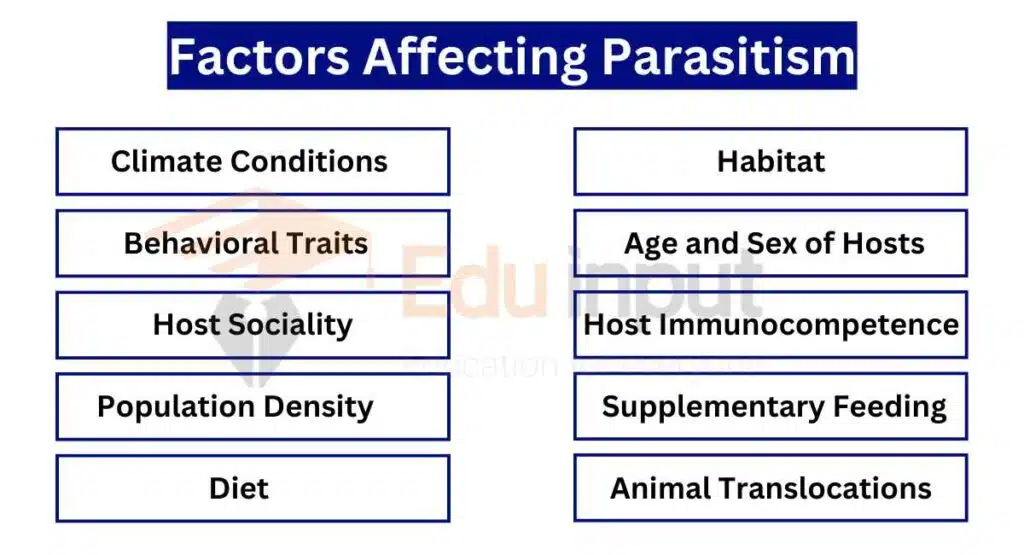
- Climate Conditions
- Behavioral Traits
- Host Sociality
- Population Density
- Diet
- Habitat
- Age and Sex of Hosts
- Host Immunocompetence
- Supplementary Feeding
- Animal Translocations



Leave a Reply